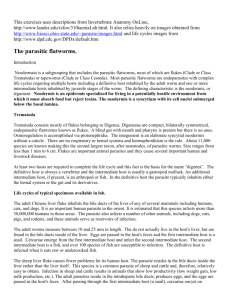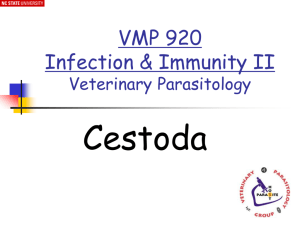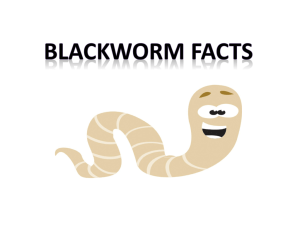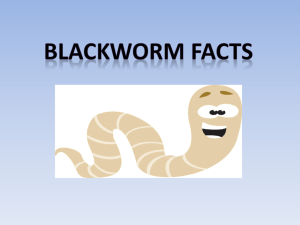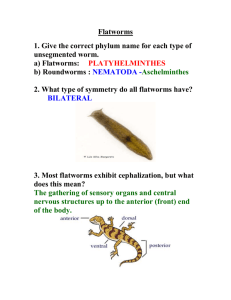Platyhelminthes
advertisement
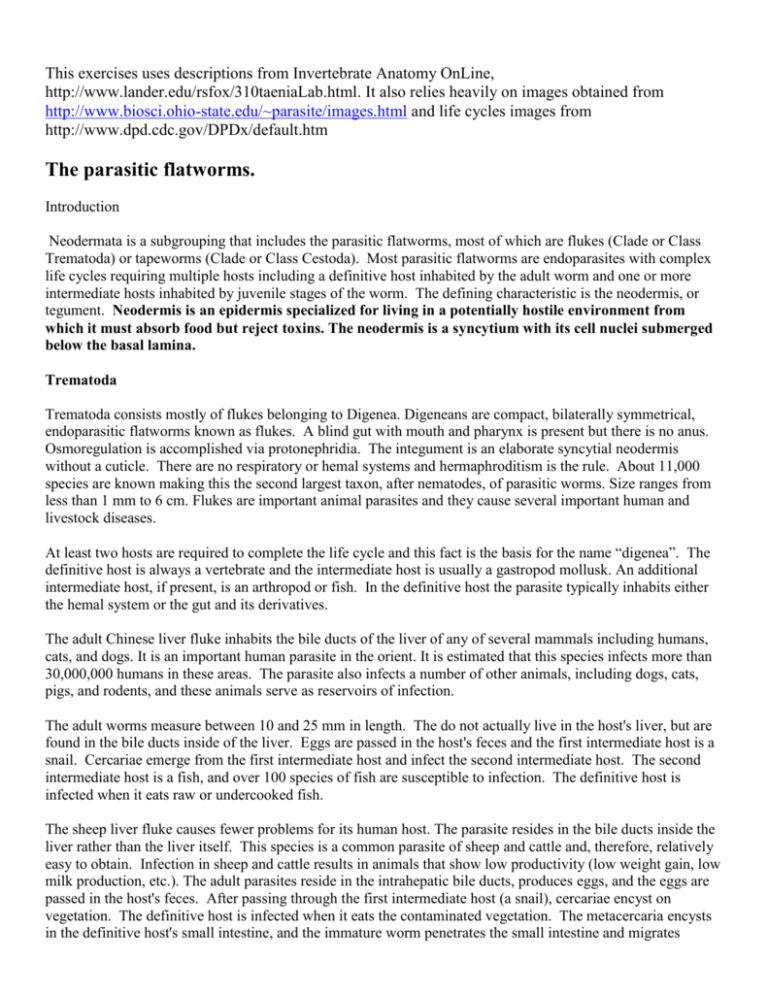
This exercises uses descriptions from Invertebrate Anatomy OnLine, http://www.lander.edu/rsfox/310taeniaLab.html. It also relies heavily on images obtained from http://www.biosci.ohio-state.edu/~parasite/images.html and life cycles images from http://www.dpd.cdc.gov/DPDx/default.htm The parasitic flatworms. Introduction Neodermata is a subgrouping that includes the parasitic flatworms, most of which are flukes (Clade or Class Trematoda) or tapeworms (Clade or Class Cestoda). Most parasitic flatworms are endoparasites with complex life cycles requiring multiple hosts including a definitive host inhabited by the adult worm and one or more intermediate hosts inhabited by juvenile stages of the worm. The defining characteristic is the neodermis, or tegument. Neodermis is an epidermis specialized for living in a potentially hostile environment from which it must absorb food but reject toxins. The neodermis is a syncytium with its cell nuclei submerged below the basal lamina. Trematoda Trematoda consists mostly of flukes belonging to Digenea. Digeneans are compact, bilaterally symmetrical, endoparasitic flatworms known as flukes. A blind gut with mouth and pharynx is present but there is no anus. Osmoregulation is accomplished via protonephridia. The integument is an elaborate syncytial neodermis without a cuticle. There are no respiratory or hemal systems and hermaphroditism is the rule. About 11,000 species are known making this the second largest taxon, after nematodes, of parasitic worms. Size ranges from less than 1 mm to 6 cm. Flukes are important animal parasites and they cause several important human and livestock diseases. At least two hosts are required to complete the life cycle and this fact is the basis for the name “digenea”. The definitive host is always a vertebrate and the intermediate host is usually a gastropod mollusk. An additional intermediate host, if present, is an arthropod or fish. In the definitive host the parasite typically inhabits either the hemal system or the gut and its derivatives. The adult Chinese liver fluke inhabits the bile ducts of the liver of any of several mammals including humans, cats, and dogs. It is an important human parasite in the orient. It is estimated that this species infects more than 30,000,000 humans in these areas. The parasite also infects a number of other animals, including dogs, cats, pigs, and rodents, and these animals serve as reservoirs of infection. The adult worms measure between 10 and 25 mm in length. The do not actually live in the host's liver, but are found in the bile ducts inside of the liver. Eggs are passed in the host's feces and the first intermediate host is a snail. Cercariae emerge from the first intermediate host and infect the second intermediate host. The second intermediate host is a fish, and over 100 species of fish are susceptible to infection. The definitive host is infected when it eats raw or undercooked fish. The sheep liver fluke causes fewer problems for its human host. The parasite resides in the bile ducts inside the liver rather than the liver itself. This species is a common parasite of sheep and cattle and, therefore, relatively easy to obtain. Infection in sheep and cattle results in animals that show low productivity (low weight gain, low milk production, etc.). The adult parasites reside in the intrahepatic bile ducts, produces eggs, and the eggs are passed in the host's feces. After passing through the first intermediate host (a snail), cercariae encyst on vegetation. The definitive host is infected when it eats the contaminated vegetation. The metacercaria encysts in the definitive host's small intestine, and the immature worm penetrates the small intestine and migrates through the abdominal cavity to the host's liver. The juvenile worm penetrates and migrates through the host's liver and finally ends up in the bile ducts. The migration of the worms through the host's liver and the presence of the worms in the bile ducts, are responsible for the pathology associated with infection. The schistosomes are unusual trematodes in that the sexes are separate (they are dioecious), they reside in the blood vessels of the definitive host, and there are no second intermediate hosts in their life cycles. There are a number of species of schistosomes that can infect humans, but most human infections are caused by one of the three following species: Schistosoma mansoni; S. haematobium; S. japonicum. Considering the distributions of all three species, schistosomiasis is distributed throughout almost all of Africa, parts of Southeast Asia, parts of northwest South America, and some islands in the Caribbean Sea. It is estimated that approximately 200,000,000 million people are infected with schistosomes, resulting in 1,000,000 deaths each year. The life cycles of the three primary species of human schistosomes are similar. The male and female worms average about 10 mm in length and live in the veins of the abdominal cavity. Here they mate and the females produce eggs. The adult worms can live 20-30 years and, depending on the species, and each female can produce several hundred eggs each day. The eggs escape from the body by penetrating the walls of the veins and small intestine or urinary bladder, and they are passed in the feces or urine. The eggs hatch in water, the first intermediate host (a snail) is infected, and cercariae are liberated from the snails. When humans come in contact with water containing cercariae, the cercariae penetrate their skin and they become infected. This occurs when the humans swim, bath, wash clothes, etc., in rivers and streams. After the cercariae penetrate the skin the immature worms enter the circulatory system and migrate to the veins of the abdominal cavity, and in about six weeks they reach sexual maturity 1. Anatomy of flukes Adult flukes. The anatomy of digenetic trematodes is usually studied in introductory laboratories using commercially prepared whole mount slides. The Chinese liver fluke, Opisthorchis (= Clonorchis) sinensis, or the sheep liver fluke, Fasciola hepatica, are the most frequently used species. We are fortunate to have slides of Schistosoma mansoni; a very important human disease causing species and an unusual fluke because the adults are dioecious or the sexes are separate. a. Your assignment is to obtain and label as best you can, one photograph of Fasciola or an adult of some other species of “typical fluke. When you look at your specimen be sure that you can distinguish the difference between the diverticula of the intestine, the vitelline glands, and the testes. The appearance of the diverticula is best seen near the mouth where it is the only structure visible. b. Then obtain and examine one slide of Schistosoma mansoni. c. In your notebook, compare the structures most evident in these specimens to those found in the free-living flatworms. You can find labeled diagrams and descriptions for flukes at the end of this lab. These are not to be memorized, but used to help you identify stages and structures in the adult. 2. Life cycles: a. If living cercariae are available in laboratory, examine these. Snails containing rediae or sporocyts may also be available for dissection. Obtain photographs and movies of all stages that you can find. The only stage that can be usually supplied easily living is the cecaria. Usually a species is chosen that infects beetles or mice as adults. Some care should be taken whenever handling parasites. Wear gloves when you dissect the snails that are carrying cecariae. Prior to the lab, Snails will probably be placed in the dark for two hours to stimulate them to release cercariae and then placed in a bowl of water. You will be able to examine the water from the bowl under the microscope. If cecariae are present, snails may be cooled and dissected to see rediae or sporocyts. We will have to wait for specific instructions, which will come with the snails, as these snails can be river or pond snails and infected with a number of trematodes If cecariae from snails are not available: b. Examine the prepared slides of the various stages of the fluke. Each pair should contribute to their notebook and a folder that will be available to the class, one photograph of one stage of the life cycle. Be careful and label soon after taking photographs because some stages in the life cycle vary more in morphology from species to species (such as rediae and sporocysts) than others (such as cecaria). Can you determine why this may be? Each photograph should be labeled with the name of the state and species. After examining the photographs, please take the following self test and record your answers in your journal. Self-test: Identify the stage in the following photographs 2a______ 2b_____ 2c_________ 2d_________ 2e____________ 2f________________ A description of the typical life cycle and diagrams of specific life cycles are included to help you associate stage with proper host. Most life cycles include two intermediate hosts (the hosts in which the parasite undergoes asexual reproduction) and a definitive host (the host in which the parasite undergoes sexual reproduction). Most adult digenetic trematodes are monoecious (a single organism contains both male and female reproductive organs), and most live in the gastrointestinal tract of the definitive host. The adult parasites produce eggs, and the eggs are passed in the definitive host's feces. The egg either hatches so the larva inside escapes and infects the first intermediate host, or the first intermediate host eats the egg. The first intermediate host is always a snail, most often an aquatic or marine snail. Inside of the snail the parasite goes through several developmental stages, and a larval stage called a "cercaria" is finally produced. The cercaria leaves the snail and swims around until it comes in contact with a second intermediate host. The cercaria penetrates the skin of the second intermediate host and encysts. This encysted stage is called a "metacercaria." The definitive host is infected when it eats an infected second intermediate host. Fish commonly serve as second intermediate hosts for digenetic trematodes, and the metacercariae encyst in the fish's muscles. In such a case the definitive host would be infected by eating the fish. Depending on complexity, these various life stages could be recognized. Egg leaves the adult containing a miricidium. Miricidia through chemoreception finds a snail, penetrates and develops into sporocysts. The sporocyst is an asexual stage with no mouth or digestive system, that absorbs nutrients through tegument and produce rediae, daughter sporocysts or cecariae. Redia are elongate forms with a muscular pharynx, that may form cercariae, or free swimming forms that leave the snail to seek another host. They encyst eventually as metacercaria to eventually be eaten by a definitive host. Oriental liver fluke: Clonorchis sinensis The sheep liver fluke: Fasciola hepatica Schistosoma 3. CESTODA or tapeworms Cestodes are compact worms whose interior is filled with unspecialized, mesenchymal connective tissue known as parenchyma, as it is in other platyhelminths. Excretion and osmoregulation are accomplished via protonephridia, which empty into two pairs of excretory canals. The nervous system includes anterior nerve rings, lateral longitudinal nerve cords, and transverse commissures. Cestodes are hermaphroditic and may utilize either self- or cross-fertilization Use the compound microscope to study whole mount slides of the scale, a mature proglottid, and a gravid proglottid. a. Choose one slide to photograph and label. b. Compare the anatomy of tapeworms with flukes in your notebook. ________________________________________________________________________________________ Information for labeling tapeworms. Use the following description as well as labeled drawing to identify important characteristics of tapeworms on prepared slides. These descriptions are taken from a online lab manual that stresses taxonomy and so most of the terms used are not to be memorized, but there as the author requests his work not be modified to any great extent. Be grateful our course is basically an appreciation course. A more colorful diagram Laboratory Specimens Commercially prepared slides of Taenia pisiformis (= T. serrata), the dog tapeworm, are frequently used in the laboratory as examples of tapeworm anatomy. Other species can also be used but differ in some respects. The adults of Taenia pisiformis occur in dogs, cats, and other carnivores and the intermediate host is a rabbit. The tapeworm body consists of an anterior, head-like scolex and the body, or strobila, consisting of a linear series of segments, or proglottids. Look at the whole mount of a scolex with the scanning lens (40X) of the compound microscope. The scolex is wider than the anterior strobila to which it joined by a narrow neck. The scolex attaches the worm to the gut wall of the host. For this purpose it has a retractable rostellum armed with two rings of hooks. Examine the hooks with higher power. Just posterior to the rostellum is a ring of four suckers, two dorsolateral and two ventrolateral. Scolex morphology varies widely with taxon. Two lateral nephridial canals may be visible on each side of the scolex. They connect with each other near the rostellum via a set of convoluted nephridial canals and extend posteriorly through the strobila. A pair of nerve rings are present but will not be evident. The strobila is long and wormlike, sometimes reaching 15 or more meters in length. (There are records of Taeniarhynchus saginatus, a human parasite, reaching lengths of more than 20 meters.) The strobila is strongly flattened dorsoventrally and is a linear series of hundreds or thousands of proglottids. The strobila includes a series of young immature proglottids at its anterior end, then a region of sexually mature proglottids in the middle, and a length of gravid proglottids at the posterior end. The gravid proglottids contain viable embryonated “eggs” ready to infect a new host should the get the opportunity. Proglottids increase in size posteriorly. Each proglottid contains its own complete hermaphroditic reproductive system as well as its share of the common excretory and nervous systems. There is no digestive system. The reproductive systems of the youngest, anteriormost proglottids are not yet formed but more posterior proglottids have increasingly better-developed reproductive systems. Most tapeworms are protandric with the male system of each proglottid maturing first. Examine a mature proglottid using 40X of the compound microscope. Your slide probably contains several proglottids, some of which may be better than others. You will probably want to make use of them all as you look for the best representation of each structure. Find the anterior and posterior ends of the proglottids. In Taenia, the posterior end of each proglottid is wider than the anterior end of the next proglottid. Respiratory, and Fluid Transport Systems Tapeworms have no mouth or gut. Organic molecules, mostly glucose, other sugars, and amino acids, are absorbed across the specialized, heavily microvillar neodermis and metabolism is largely anaerobic. There is no need for a gas exchange mechanism and there is none. Food and waste molecules diffuse to and from the body surface and there is no fluid transport system. The microvilli of the neodermis absorb food molecules from the environment. Excretory System The excretory system consists of numerous flame bulb protonephridia scattered throughout the parenchyma of each proglottid but they are not evident in these preparations. Individual protonephridia drain into an elaborate system of nephridial canals, which ultimately open to the exterior at the posterior end of the strobila. Dorsal and ventral lateral nephridial canals on each side of each proglottid extend the length of the worm. In addition to the two nephridial canals, each side possesses a longitudinal nerve cord which may be confused with the canals. The visibility of these structures depends on the quality of the staining and they are often indistinct. The larger ventral nephridial canal is a pale, wide, longitudinal band lateral to the testes (Fig 2). The dorsal canal is much smaller in diameter and is located medial to the ventral canal, between it and the testis. In each proglottid the right and left ventral canals are connected by a transverse nephridial canal extending across the posterior edge of the proglottid just anterior to the junction with the next proglottid. Reproductive System Male Most structures in the proglottid belong to the reproductive system. The male and female systems share a common genital pore ( = gonopore) and genital atrium but are otherwise independent of each other. The common genital pore (Fig 2) is a large aperture on either the right or left side of the proglottid. It opens into a shallow, cuplike genital atrium. The male and female systems both open into the atrium via its own gonoduct. Find the two ducts joining the medial border of the genital atrium. The anterior duct is the thicker and is the male gonoduct. The gonoduct is regionally specialized. The wide portion of the gonoduct attached to the atrium is the muscular cirrus sac. Inside the sac is the convoluted, eversible, tubular cirrus, which is the intromittent organ, or penis. During copulation the cirrus is extended from the genital pore and inserted into the genital atrium and vagina of another proglottid. On your slide it may be everted in some proglottids, in which case it looks like a slender worm extending from the genital pore. The next region of the male gonoduct is the tubular sperm duct, also convoluted, which extends to the testes. Its entire length is not visible. The testes are numerous small spheres scattered throughout the parenchyma. A tiny tributary of the sperm duct drains each, but these cannot be seen Female The smaller and more posterior of the two ducts entering the genital atrium is them female gonoduct, which is also regionally specialized. The first region is the vagina. It receives the partner's cirrus during copulation. The vagina extends medially and posteriorly to become the small seminal receptacle . This is a clear, unstained, oval chamber where allosperm received through the vagina are stored. It is usually easily visible. A short duct exits the posterior end of the seminal receptacle and joins the oviduct. The germarium (= ovary) is divided into large right and left lobes lying on either side of the seminal receptacle. It is the site of oogenesis and produces large numbers of small, yolkless oocytes. The two lobes of the germarium are connected across the midline by a short, wide, transverse isthmus. The follicles of the germarium open into small ducts which drain into the isthmus. The narrow oviduct arises from the isthmus and extends posteriorly for a short distance before receiving the duct from the seminal receptacle . The isthmus is usually easy to see but the oviduct is often obscured by the seminal receptacle and is harder to find. After receiving the duct from the seminal receptacle the oviduct continues posteriorly to the ootype. Fertilization occurs in the oviduct. Yolk cells are produced by the single vitellarium at the posterior end of the proglottid. A small uterine duct, usually not discernible, extends to the uterus . Shelled eggs move through the uterine duct into the uterus. Within the shell meiosis is completed, a zygote forms, and development proceeds to the larval stage. The uterus is a blind sac with lateral branches in which embryonated “eggs” are stored. The size and visibility of the uterus vary with the maturity of the proglottid. As the proglottid ages the accumulating “eggs” cause the uterus to become larger, darker, and more visible. They will eventually fill it, distending it so it occupies the entire proglottid. There is no opening of the uterus to the exterior and eggs are released by rupture of the proglottid. _____________________________________________________________________________________ Information for labeling flukes: External Features Note the size and shape of the worm. Does anterior end of the worm narrows gradually to a pointed tip? Is the wider posterior end is bluntly rounded? At the extreme anterior end you should note a conspicuous oral sucker surrounds the mouth and is used to attach to the host and maintain its position. The circular ventral sucker, or acetabulum, may be located on the ventral surface a short distance posterior to the oral sucker. It also attaches to the host but is not associated with the gut. Body Wall The body wall consists of an outer syncytial neodermis whose nuclei are sunken deep within the body. The true epidermis is lost during larval development. There is no cuticle. Muscles underlie the neodermis and a mesenchymal parenchyma fills the interior of the animal. Organs are embedded in the parenchyma. Trematodes, like other flatworms, are compact (acoelomate) and have neither mesodermal body cavity. Digestive System The mouth opens into a muscular, bulbous pharynx, which is used to suck food into the gut. The esophagus quickly bifurcates to form two long, unbranched intestinal ceca that extend along the sides to the posterior end of the worm. Hydrolysis and absorption occur in these ceca. They end blindly and there is no anus. . Flukes also absorb nutriment directly across the cuticle-free neodermis. Excretory/Osmoregulatory System Protonephridia are scattered through the mesenchyme but they are not visible in these preparations. They drain into a pair of branching, lateral excretory canals, which likewise are usually not visible. The lateral canals drain into a large median excretory bladder at the posterior end of the worm. The bladder, which is more easily observed, opens to the exterior by a large nephridiopore at the posterior end of the worm. Reproductive System Most flukes are hermaphroditic and have a complex reproductive system with independent male and female systems. The reproductive system is large and well-developed, occupying a large proportion of the interior, as is often the case with parasites. Many of the ducts mentioned in the following descriptions are difficult to find. The exception to this rule is the blood fluke. In this species females can be found lying within a ventral groove of the male called the gynecophoral canal, an obvious adaptation to these worms living in a "turbulent" environment (the host's blood stream). Male System The male system begins with two large, irregularly branched testes located in the posterior third of the worm . The testes are large, easily seen, and usually stain dark pink. Each has a central area from which extend wide, blunt, branched lobes reminiscent of the pseudopodia of Amoeba. A slender, inconspicuous vas efferens, which you probably will not see, arises near the center of each testis. The two vasa efferentia unite near the middle of the body to form the short vas deferens which is obscured by the voluminous uterus in the center of the worm. The vas deferens quickly widens to become the muscular seminal vesicle. This meandering tube extends anteriorly and eventually joins the uterus and the two open together to the exterior via the common gonopore. In ventral view the seminal vesicle is hidden by the uterus and may be difficult to observe. The seminal vesicle stores autosperm produced by the testes. The common gonopore, or genital pore, is on the ventral surface immediately anterior to the ventral sucker. It is small and obscure but usually appears as a small pink spot on the anterior edge of the ventral sucker. Fasciola has an eversible copulatory cirrus, Clonorchis relies instead on the muscular seminal vesicle to transfer sperm. Female System The female system is more complex, partly because the trematodes produce eggs consisting of an oocyte surrounded by yolk cells. Oocytes are produced by the ovary whereas yolk cells are produced by two independent vitellaria. Begin with the easily located seminal receptacle, a large, ovoid organ where all sperm (from another worm) are stored. The seminal receptacle is drained by the sperm duct, which joins the oviduct. The single germanium (ovary) stains dark pink and lies on the midline immediately anterior to the seminal receptacle. The germarium is smaller (and usually darker) than the seminal receptacle. The germarium connects with the ootype via the oviduct, neither of which is visible. The ootype is a glandular chamber near the center of the worm but it usually cannot be seen in these preparations . The two large vitellaria produce yolk cells. They lie lateral to the intestinal ceca, between the ceca and the edge of the body. They are large and are usually brownish-yellow in stained preparations. Each is drained by a large, easily seen vitelline duct (= vitellarium duct). The two ducts join each other to form a short common duct that empties into the ootype. The large brown uterus exits the ootype and extends anteriorly to its union with the seminal vesicle at the common gonopore. It is a wide convoluted tube packed with dark, yellow-brown eggs. The uterus and seminal vesicle share the common gonopore. Some diagrams to help you Fasciola hepatica Clonorchis sinensis
